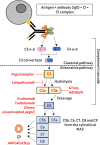Treatments for dry age-related macular degeneration: therapeutic avenues, clinical trials and future directions
- PMID: 33741584
- PMCID: PMC8867261
- DOI: 10.1136/bjophthalmol-2020-318452
Treatments for dry age-related macular degeneration: therapeutic avenues, clinical trials and future directions
Abstract
Age-related macular degeneration (AMD) is the leading cause of irreversible blindness in the developed world. The identification of the central role of vascular endothelial growth factor (VEGF) in the pathogenesis of neovascular AMD and the introduction of anti-VEGF agents as gold-standard treatment, have drastically changed its prognosis-something yet to be seen in dry AMD. Several therapeutic avenues with a wide variability of targets are currently being investigated in dry AMD. The approaches being investigated to reduce the rate of disease progression include, (1) drugs with antioxidative properties, (2) inhibitors of the complement cascade, (3) neuroprotective agents, (4) visual cycle inhibitors, (5) gene therapy and (6) cell-based therapies. A number of early phase clinical trials have provided promising results, with many more ongoing and anticipated in the near future. In this review, we aim to provide an update of the interventional trials to date and future prospects for the treatment of dry AMD.
Keywords: angiogenesis; degeneration; genetics; macula; retina.
© Author(s) (or their employer(s)) 2022. Re-use permitted under CC BY. Published by BMJ.
Conflict of interest statement
Competing interests: The authors alone are responsible for the content and writing of this article. MM and MG consult for MeiraGTx Ltd.
Figures

Similar articles
-
Treatment of dry age-related macular degeneration: A review.Clin Exp Ophthalmol. 2023 Nov;51(8):835-852. doi: 10.1111/ceo.14294. Epub 2023 Sep 22. Clin Exp Ophthalmol. 2023. PMID: 37737509 Review.
-
Dry and neovascular "wet" age-related macular degeneration: Upcoming therapies.Indian J Ophthalmol. 2025 Jan 1;73(Suppl 1):S55-S65. doi: 10.4103/IJO.IJO_1120_24. Epub 2024 Oct 25. Indian J Ophthalmol. 2025. PMID: 39446815 Free PMC article. Review.
-
Recent Developments in the Treatment of Wet Age-related Macular Degeneration.Curr Med Sci. 2020 Oct;40(5):851-857. doi: 10.1007/s11596-020-2253-6. Epub 2020 Oct 29. Curr Med Sci. 2020. PMID: 32980899 Review.
-
Different Therapeutic Approaches for Dry and Wet AMD.Int J Mol Sci. 2024 Dec 4;25(23):13053. doi: 10.3390/ijms252313053. Int J Mol Sci. 2024. PMID: 39684764 Free PMC article. Review.
-
Progression of macular atrophy in patients undergoing anti-vascular endothelial growth factor therapy for neovascular age-related macular degeneration.Acta Ophthalmol. 2021 Jun;99(4):e540-e546. doi: 10.1111/aos.14631. Epub 2020 Sep 30. Acta Ophthalmol. 2021. PMID: 32996674
Cited by
-
Oxidative Stress and Antioxidants in Age-Related Macular Degeneration.Antioxidants (Basel). 2023 Jul 3;12(7):1379. doi: 10.3390/antiox12071379. Antioxidants (Basel). 2023. PMID: 37507918 Free PMC article. Review.
-
Review: Mechanisms of TIMP-3 accumulation and pathogenesis in Sorsby fundus dystrophy.Mol Vis. 2024 Mar 3;30:74-91. eCollection 2024. Mol Vis. 2024. PMID: 38601018 Free PMC article. Review.
-
Adaptive Optics-Transscleral Flood Illumination Imaging of Retinal Pigment Epithelium in Dry Age-Related Macular Degeneration.Cells. 2025 Apr 24;14(9):633. doi: 10.3390/cells14090633. Cells. 2025. PMID: 40358157 Free PMC article.
-
Vitreous humor proteome: unraveling the molecular mechanisms underlying proliferative and neovascular vitreoretinal diseases.Cell Mol Life Sci. 2022 Dec 31;80(1):22. doi: 10.1007/s00018-022-04670-y. Cell Mol Life Sci. 2022. PMID: 36585968 Free PMC article. Review.
-
Cigarette smoke causes a bioenergetic crisis in RPE cells involving the downregulation of HIF-1α under normoxia.Cell Death Discov. 2023 Oct 25;9(1):398. doi: 10.1038/s41420-023-01695-5. Cell Death Discov. 2023. PMID: 37880219 Free PMC article.
References
Publication types
MeSH terms
Substances
Grants and funding
LinkOut - more resources
Full Text Sources
Other Literature Sources
